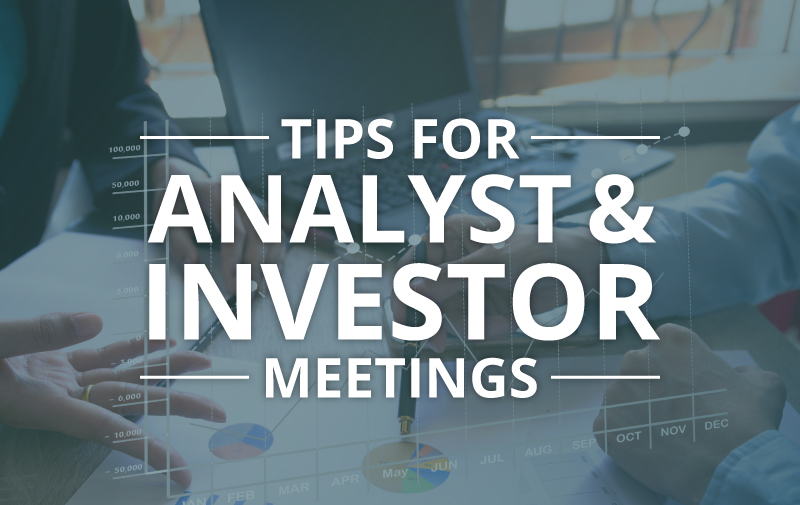Things to Consider Before, During, and After Meetings with Wall Street
A fundamental component of a proactive investor relations program includes regular outreach and meetings with sell-side analysts and investors. We recommend showing a public company plan to the investment community for 2-3 days at least once a quarter. Those meetings can take many forms, including 1×1 meetings at an investment bank-sponsored conference, a non-deal roadshow (NDR) or site visits.
As part of the planning process, we’ve developed a checklist of reminders to consider when preparing for these meetings, during the meetings, and after the meetings.
Meeting preparation
- Know your audience. Know the basic background for a sell-side meeting such as coverage list and model estimates; for the buy-side, know their investment style (value, growth, momentum, etc.) and if they are a current or historic shareholder. Do they own your company or a competitor? What’s their level of familiarity with your company or the sector? If possible, consolidate into a document that can be quickly reviewed before a meeting. This will help you tailor your remarks accordingly.
- Inquire ahead of time if there are specific topics or questions that need to be addressed. Do they have a model prepared? Knowing these things in advance can ensure the meeting stays on track and the right people attend.
- Consider what the “ask” will be or what you expect to gain from the meeting. This can range from insightful feedback from an analyst covering your sector to confirming that a current investor is up to speed and confident in your growth plan.
- Ensure the talking points and disclosures are consistent among speakers. If you have this option, it’s good to rotate speakers on a lengthy day of 1x1s or a multi-day roadshow to provide a break and the opportunity to listen to how others present the same material.
- Prepare for Q&A by answering practice questions out loud (not reading from a prep document). Practice saying, “That is not something we disclose” or “I’ll check on that and get back to you.”
- Review Reg FD rules and the definition of material information. Determine what metrics are public and which ones are strictly internal. Ensure that everyone who is potentially speaking during the meetings is also apprised of the rules.
- Post the deck you plan to use in your meetings on your website. That way, you don’t need to carry handouts, and you can reference it in discussions or pull it up if needed.
During the meeting
- Set the stage for the meeting. Start by asking something about the people sitting across the table, such as “Can you tell me a little about your fund?” If that’s not possible (or necessary), start with an opening remark about your recent results or milestone; then ask if they want to run through the deck or jump right to Q&A.
- Maintain a positive, neutral tone. It is ok to be optimistic and even bullish, but don’t ignore the realities that may face your business and market sector. Acknowledge an investor or analyst’s concerns and explain how your position is different without being dismissive or argumentative.
- Don’t state a conclusion you think your audience should make (e.g., “There’s never been a better time to invest in us!”); rather, remind your audience of the three or four important things you want them to remember in order to draw the conclusion you want them to make.
- Avoid making forward-looking statements or projections. Stick to information that is publicly available and keep the metrics offered consistent from one meeting to the next.
- If asked about the competition, highlight your company’s competitive advantages instead of your competitors’ weaknesses. Try to avoid using competitors’ names.
- Keep your answers succinct. Not only is it hard to follow a rambling thread, but this is most often when inadvertent disclosures are made.
- Be mindful and respectful of the scheduled start and end time for the meeting.
- Try to save a few minutes at the end of the discussion to ask for any feedback and follow up. This demonstrates that you are interested in their opinion and hopefully opens the door to discussing a next step.
After the meeting
- Send a follow up email and reiterate your request for any feedback or next steps.
- Capture notes, questions, and common themes from the meetings. This will be very helpful in crafting content for your next earnings call and Q&A prep.
- Review feedback with your communications (IR, PR, Marketing) teams to ensure that the ideas are universally captured and incorporated into new materials, if necessary.
- Review your investor deck while it’s still fresh. What slides did you tend to skip and which ones seem repetitive? Consider replacing or deleting. Also, what common themes emerged in your meetings that you may want to reinforce in new slides.
- Track your meeting history in one place. This can be useful in referencing during future meetings, tracking frequency of meetings, and determining the potential impact a meeting had on shareholder ownership trends.
Meeting with sell-side analysts and investors is an ongoing part of a public company’s responsibilities. For more tips and help in preparation for these important meetings, contact us.
NOTE: Some of these suggestions were included in an eGroup forum discussed among members of The National Investor Relations Institute (NIRI), a professional association of corporate officers and investor relations consultants responsible for communication among corporate management, shareholders, securities analysts and other financial community constituents. NIRI offers its members information resources, networking, and a range of educational opportunities, and it is a valuable resource for anyone responsible for investor relations functions.
Leigh Salvo, Managing Director


Leave a Reply